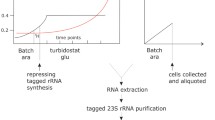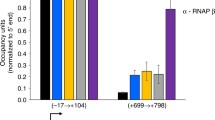Abstract
To investigate the physiological roles of translation initiation factor IF3 and ribosomal protein L20 inEscherichia coli, theinfC, rpmI andrpIT genes encoding IF3, L35 and L20, respectively, were placed under the control oflac promoter/operator sequences. Thus, their expression is dependent upon the amount of inducer isopropyl thiogalactoside (IPTG) in the medium. Lysogenic strains were constructed with recombinant lambda phages that express eitherrpmI andrplT orinfC andrpmI in trans, thereby allowing depletion of only IF3 or L20 at low IPTG concentrations. At low IPTG concentrations in the IF3-limited strain, the cellular concentration of IF3, but not L20, decreases and the growth rate slows. Furthermore, ribosomes run off polysomes, indicating that IF3 functions during the initiation phase of protein synthesis in vivo. During slow growth, the ratio of RNA to protein increases rather than decreases as occurs with control strains, indicating that IF3 limitation disrupts feedback inhibition of rRNA synthesis. As IF3 levels drop, expression from an AUU-infC-lacZ fusion increases, whereas expression decreases from an AUG-infC-lacZ fusion, thereby confirming the model of autogenous regulation ofinfC. The effects of L20 limitation are similar; cells grown in low concentrations of IPTG exhibited a decrease in the rate of growth, a decrease in cellular L20 concentration, no change in IF3 concentration, and a small increase in the ratio of RNA to protein. In addition, a decrease in 50S subunits and the appearance of an aberrant ribosome peak at approximately 41–43S is seen. Previous studies have shown that the L20 protein negatively controls its own gene expression. Reduction of the cellular concentration of L20 derepresses the expression of anrplT-lacZ gene fusion, thus confirming autogenous regulation by L20.
Similar content being viewed by others
References
Baughman G, Nomura M (1983) Localization of the target site for translational regulation of the L11 operon and direct evidence for translational coupling inEscherichia coli. Cell 34:979–988
Bennett PM, Maaloe O (1974) The effects of fusidic acid on growth, ribosome synthesis and RNA metabolism inEscherichia coli. J Mol Biol 90:541–561
Butler JS, Springer M, Dondon J, Graffe M, Grunberg-Manago M (1986)Escherichia coli protein synthesis initiation factor IF3 controls its own gene expression at the translational level in vivo. J Mol Biol 192:767–780
Butler JS, Springer M, Grunberg-Manago M (1987) AUU-to-AUG mutation in the initiator codon of the translation initiation factor IF3 abolishes translational autocontrol of its own gene (infC) in vivo. Proc Natl Acad Sci USA 84:4402–4025
Churchward G, Bremer H, Young R (1982) Transcription in bacteria at different DNA concentrations. J Bacteriol 150:572–581
Cole JR, Olsson CL, Hershey JWB, Grunberg-Manago M, Nomura M (1987) Feedback regulation of rRNA synthesis inEscherichia coli: requirement for initiation factor IF2. J Mol Biol 198:383–392
Dabbs ER, Hasenbank R, Kastner B, Rak KH, Wartusch B, Stöffler G (1983) Immunological studies ofEscherichia coli mutants lacking one or two ribosomal proteins. Mol Gen Genet 192:301–308
Elder JH, Pickett RA, Hampton J, Lerner RA (1977) Radioiodination of proteins in single polyacrylamide gel slices. Tryptic peptide analysis of all the major members of complex multicomponent systems using microgram quantities of total protein. J Biol Chem 252:6510–6515
Gold L, Stormo G, Saunders R (1984)Escherichia coli translational initiation factor IF3: a unique case of translational regulation. Proc Natl Acad Sci USA 81:7061–7065
Gourse RL, Takabe Y, Sharrock RA, Nomura M (1985) Feedback regulation of rRNA and tRNA synthesis and accumulation of free ribosomes after conditional expression of rRNA genes. Proc Natl Acad Sci USA 82:1055–1073
Gualerzi CO, Pon CL (1990) Initiation of mRNA translation in prokaryotes. Biochemistry 29:5881–5889
Guthrie C, Nashimoto H, Nomura M (1969) Structure and function ofE. coli ribosomes. VIII. Cold-sensitive mutants defective in assembly. Proc Natl Acad Sci USA 63:384–391
Jinks-Robertson S, Gourse RL, Nomura M (1983) Expression of rRNA and tRNA genes inEscherichia coli: evidence for feedback regulation by products of rRNA operons. Cell 33:865–876
Jinks-Robertson S, Nomura M (1987) InEscherichia coli andSalmonella typhimurium: cellular and molecular biology. (FC, Neidhardt. eds). Am. Soc. Micro. Washington D.C., pp 1358–1385
La Teana A, Pon CL, Gualerzi CO (1994) Translation of mRNAs with degenerate initiation triplet AUU displays high initiation factor 2 dependence and is subject to initiation factor 3 repression. Proc Natl Acad Sci USA 90:4161–4165
Laemmli UK (1970) Cleavage of structural proteins during the assembly of the head of bacteriophage T4. Nature 227:680–685
Lesage P, Truong H-N, Graffe M, Dondon J, Springer M (1990) Translated translational operator inEscherichia coli: auto-regulation in theinfC-rpmI-rplT operon. J Mol Biol 213:465–475
Lesage P, Chiaruttini C, Graffe M, Dondon J, Milet M, Springer M (1992) Messenger RNA secondary structure and translational coupling in theEscherichia coli operon encoding translation initiation factor IF3 and the ribosomal proteins L35 and L20. J Mol Biol 228:366–386
Lewandowski LJ, Brownstein BL (1969) Characterization of a 43S ribonucleoprotein component of a mutant ofEscherichia coli. J Mol Biol 41:277–290
Maaloe O, Kjeldgaard NO (1966) Control of macromolecular synthesis. WQ Benjamin, New York
MacDonald RE, Turnock G, Forchhammer J (1967) The synthesis and function of ribosomes in a new mutant ofEscherichia coli. Proc Natl Acad Sci USA 57:141–147
Maniatis T, Fritsch E, Sambrook J (1982) Molecular cloning: a laboratory manual. Cold Spring Harbor Laboratory, Cold Spring Harbor, New York
Miller JH (1972) Experiments in molecular genetics. Cold Spring Harbor Laboratory Press, Cold spring Harbor, New York
Murray K, Murray NE (1975) Phage lambda receptor chromosomes for DNA fragments made with restriction endonuclease III ofHaemophilus influenzae and restriction endonuclease I ofEscherichia coli. J Mol Biol 98:551–575
Nashimoto H, Nomura M (1970) Structure and function of bacterial ribosomes. XI. Dependence of 50S ribosomal assembly on simultaneous assembly of 30S subunits. Proc Natl Acad Sci USA 67:1440–1447
Neidhardt FC, Bloch PL, Smith DF (1974) Culture medium for enterobacteria. J Bacteriol 119:736–747
Nowotny V, Nierhaus KH (1980) Protein L20 from the large subunit ofEscherichia coli ribosomes is an assembly protein. J Mol Biol 137:391–399
Tai P-C, Kessler DP, Ingraham J (1969) Cold-sensitive mutations inSalmonella typhimurium which affect ribosome synthesis. J Bacteriol 97:1298–1304
Towbin H, Staehelin T, Gordon J (1979) Electrophoretic transfer of proteins from polyacrylamide gels to nitrocellulose sheets: procedure and some applications. Proc Natl Acad Sci USA 76:4350–4354
Wada A (1986) Analysis ofEscherichia coli ribosomal proteins by an improved two-dimensional gel electrophoresis. I. Detection of four new proteins. J Biochem 100:1583–1594
Yamagishi M, deBoer HA, Nomura M (1987) Feedback regulation of rRNA synthesis: a mutational alteration in the anti-Shine-Dalgarno region of the 16S rRNA gene abolishes regulation. J Mol Biol 198:547–550
Zengel JM, Lindahl L (1994) Diverse mechanisms for regulating ribosomal protein synthesis inEscherichia coli. Proc Nucleic Acid Res Molec Biol 47:331–369
Author information
Authors and Affiliations
Additional information
Communicated by K. Isono
Rights and permissions
About this article
Cite this article
Olsson, C.L., Graffe, M., Springer, M. et al. Physiological effects of translation initiation factor IF3 and ribosomal protein L20 limitation inEscherichia coli . Molec. Gen. Genet. 250, 705–714 (1996). https://doi.org/10.1007/BF02172982
Received:
Accepted:
Issue Date:
DOI: https://doi.org/10.1007/BF02172982




